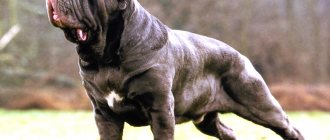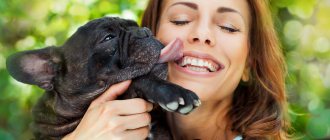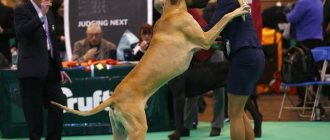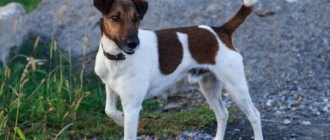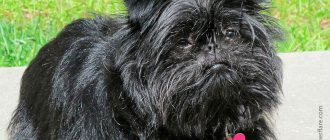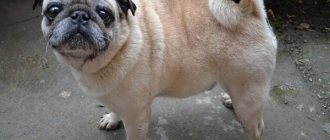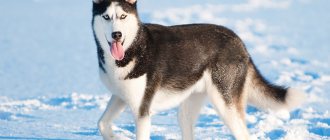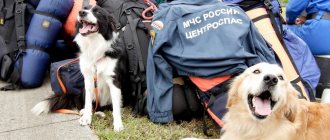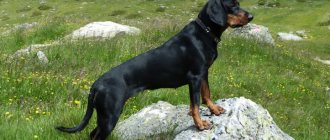Brief description of the breed
The appearance of the Fox Terrier has remained virtually unchanged since the end of the 18th century, when the breed was developed. The breed itself is divided into two types: smooth-haired and wire-haired. Smooth Fox Terrier
has a soft, smooth coat that gives the dog an elegant appearance.
The Wire Fox Terrier
has a more stylish appearance, but requires more attention when it comes to grooming. Both varieties are very friendly and sociable, they are very active and inquisitive. The main difference between these two fox terriers is only the coat, and how to care for it. Otherwise, these dogs are almost the same.
The Smooth Fox Terrier has a smooth or wiry coat that does not shed much. The hair of these dogs is very dense. Its density in normal hair condition should be such that it is difficult for you to see the skin when separating the hair with your fingers. This is due to the fact that healthy dogs of this breed have a short but fairly dense undercoat.
Previously, white color was especially valued among fox terriers of various varieties. Today, according to the official description of the breed, these dogs can be black, brown or black-brown with spots. As a rule, representatives of this breed have a single color, but, as already noted, inclusions of a different color are allowed, so this color is also considered the norm. Most often, Fox Terriers have markings on the face and ears.
But as for the brindle and red colors, such colors are not entirely desirable for dogs of this breed. The same applies to the fawn color. The presence of this color, accordingly, is not an indicator of the “uniqueness” of the dog. The color will not affect the development of the dog or its condition in any way, but you should not pay extra to the seller for a “rare” color.
The Smooth Fox Terrier is somewhat less common. This may seem strange, since it was the smooth-haired, and not the wire-haired, fox terrier that was officially recognized as a separate breed by the English Kennel Club in 1875.
Fox terriers were irreplaceable assistants to hunters. These active dogs managed to pull out a hidden fox from a hole. The hunt took place in not very favorable conditions, so the smooth fox terriers were more vulnerable than their wire-haired counterparts. Today the breed is practically not used during hunting, but the dog’s hunting instincts have not dried up. Owners of such pets will definitely notice with what pleasure dogs dig holes, trying to find prey in them, for example, a mole.
The breed is distinguished by good health and endurance. Puppies, as a rule, are not particularly picky and fit well into the family. These are pets who love to play with children, they are active, and sometimes even picky towards their fellows. Of course, fox terriers need timely socialization. The dog’s relationship with other pets will depend on this.
The Fox Terrier is a confident and endlessly curious dog. Such a desire to understand everything around him obliges the owner to worry about a reliable fence, which should become an obstacle to the pet’s boundless desire to break out to explore the world. In addition, the dog’s activity indicates that it is unsafe to walk with a fox terrier without a leash, which will protect you from having to catch your pet chasing a cat through the streets.
The dog's keen intelligence has made fox terriers easy to train. They just “grab everything on the fly.” Pets will happily perform various commands and tricks, but training must be approached with full responsibility and professionalism.
Dogs of this breed need a lot of active exercise. Since fox terriers’ energy simply splashes out, it needs to be realized. If you want your dog to be healthy and obedient, it must be tired from exercise. True, most likely, the owner will get tired first, not the dog.
Fox Terriers make good watchdogs. The dog will bark until it sees the owner's reaction. The animal must be taught guard skills from an early age. Only in this case can you sleep peacefully, knowing that a reliable security guard is guarding your home.
Care, walks, rules of education
Elderly people and families with small children (under 10 years old) should not have hyperactive dogs. A person who is too nervous or, conversely, phlegmatic, will not be able to withstand Fox. It is better if the owner is young, athletic, willing to spend a lot of time raising the fox terrier at home, or a professional hunter.
Features of care:
- comb once a week, during the molting period - 2 times every 7 days. The Wire Fox Terrier group needs trimming (watch training videos on how to do this correctly). It is necessary to take care of the coat, since Foxes shed heavily and the short white bristles cannot be pulled out of things;
- bathing - when dirty, washing paws - after each walk;
- Clean your ears once a month;
- food - natural or factory feed. The frequency of feedings is up to 3 months 5-6 times a day, up to six months - 4-5, from 9 months you can switch to two meals a day. When preparing your own diet, focus on the age, living conditions, and activity of the student;
- The first walk of the puppy is on the 15th day after repeated vaccination, the time is no more than 15 minutes. Gradually the duration of the walk is increased to at least 2 hours.
These animals are in good health, but they have a very high pain threshold. Therefore, you need to be careful not to miss the moment when they are injured or feel unwell.
Fox Terriers cannot stand being alone. They need to be brought up so that they calmly react to the temporary absence of family around them.
The pet constantly tests the owner's strength. Only if human authority is maintained will the animal be obedient and controllable.
The peculiarity of the breed is “talkativeness”. Loud barking for no reason can become a problem in a city apartment without sound insulation. You need to train to give voice on command (use video lessons from experienced dog handlers).
Foxes are intolerant of other dogs and small rodents.
Innate hunting instincts have given rise to a passion in terriers for digging holes and chasing after any type of transport, so do not let your pupil go for a walk on the street. Walk only on a leash, even if you are 100% sure that your pet can be controlled.
Where to start raising a Fox Terrier puppy:
- accustom to a nickname;
- instill cleanliness skills - take the puppy outside after eating and wait for him to do his business. Encourage correct actions with praise and treats;
- Accustomed to a leash and collar. Wear initially for a short time at home;
- from 3 months they teach a general training course (classes on mastering basic commands), and conduct lessons on practicing obedience skills.
Don't overload your puppy. Do short lessons (10-15 minutes each), exercises 2-3 times a day in the form of a game.
basic information
| Breed name: | Fox terrier |
| Country of origin: | Great Britain |
| Time of origin of the breed: | end of the 18th century |
| Type: | terriers |
| Weight: | 6 – 8 kg |
| Height (height at withers): | 35 – 40 cm |
| Lifespan: | 12 – 14 years old |
| ICF classification: | Group 3, Section 1, Number 12/169 |
| Price of puppies: | 120 – 1100 $ |
| The most popular nicknames: | list of names for fox terrier |
Breeds // Fox Terrier Wirehaired
Fox Terrier at Dogcity classes
Country of origin. Great Britain.
General form. A medium-sized, harmoniously built, square-format dog is truly the standard of a terrier. He is smart and cheerful, passionate and dexterous, brave and agile, vigilant and wary, extremely resilient and assertive. This is a true burrowing dog with a well-expressed anger towards the beast, and its hard, wire-like fur with a break allows it to feel free in the burrow.
Sexual type. Well expressed. Males are more massive, more courageous, females are lighter in build. Flaws. Slight deviations from the sexual type. Vices. Sharp deviations from the sexual type; females in male type.
Features of behavior and character. The Fox Terrier must be agile, temperamental, courageous, with obvious aggression towards the animal and distrustful of strangers. The type of higher nervous activity is balanced, mobile. Flaws. Lethargy, timidity, nervousness, anger towards a person. Vices. Cowardice, phlegmaticity, aggression towards humans and its absence towards animals.
Constitution type. Strong-dry or dry-strong, with strong but not rough bones and dense, well-developed prominent muscles. The skin is elastic, tight-fitting. Flaws. Some lightness or coarseness of build, insufficiently expressed muscles. Vices. Significant deviations from the desired type of constitution; roughness, dampness and looseness of build; obesity, exhaustion.
Height and weight. Height at the withers: for males - 35-39 cm, for females - 34-38 cm. Weight: for males - 7.3-8.2 kg, for females - 6.8-7.7 kg. Exhibition weight - 7-8 kg. Flaws. The height at the withers is 1 cm less than the minimum. Faults. The height at the withers is 2 cm less than the minimum or higher than the maximum.
Format. Square. Format index - 100-102. Flaws. Minor deviations from the specified format. Vices. Shortened (less than 98) or extended format.
Coat. The coat is thick, very hard to the touch, with a rich soft undercoat. It is wiry on the withers (2 cm long), back and limbs (up to 4 cm long), and in show form it should have 2-3 cm on the body and limbs and 1-1.5 cm on the head. In the last third, the hair has a break, which contributes to the formation of a tight coat (“closed shirt”). After trimming, the long bristly hair on the upper and lower jaws - whiskers, beard, as well as bushy eyebrows - gives the muzzle a rectangular shape. The natural change of coat, molting, is not pronounced. It is replaced by grooming, stripping and trimming, including hair trimming, which is a mandatory requirement to give the dog standard show shape. Flaws. Insufficiently curved, straight hair, insufficiently hard, thick and dense coat; soft hair on the face and limbs with hard hair on the body; insufficient hair growth on the face and limbs; poor preparation of wool for exhibition; improper haircut; excessively long or very short, late trimmed coat. Vices. Soft, curly or straight, standing coat (“open shirt”); absence of hair on the face and limbs or trimming.
Color. Pure white and piebald - with black and/or tan spots. Saturation and clearly defined spots are desirable. White color should predominate. Vices. Large colored spots displacing the main white background, variegated, red, liver spots.
Head. Long (approximately 2 cm more than the height of the dog at the withers), dry, wedge-shaped, gradually tapering towards the eyes and then towards the nose. The skull is flat, not wide. The head circumference is no more than 8 cm at minimum and 9 cm at maximum height in males (in females, 7.5 cm and 8.5 cm, respectively). The occipital protuberance is poorly defined. Cheekbones are emphasized but not prominent. The cheek muscles are flat. The transition from forehead to muzzle is smooth. The muzzle is almost equal in length to the skull or slightly longer, well filled under the eyes, gradually tapering to a large black nose with well-opened nostrils. When viewed from the side, the lines of the skull and muzzle are parallel. The lips are dry, tightly fitting, with a black border. The upper lip should not cover the lower lip. The jaws are strong and well developed, but the chewing muscles do not protrude. Flaws. Rounded forehead, slight cheekbones, protruding occipital protuberance, a noticeable transition from the forehead to the muzzle, the back of the head somewhat sloping back; the muzzle is light or rough, slightly lowered or pointed. Vices. Rough or light head, convex or sloping forehead, cheekbones or cheekiness, upturned, sharply drooping, blunt, sharp, short muzzle, incomplete pigmentation of the nose and lips.
Ears. Hanging on cartilage, small, medium thickness, triangular in shape, without wrinkles or dents. The upper fold line of the ears rises up to 2 cm above the level of the skull. The ears are set high and close to each other. Their ends are directed towards the outer corners of the eyes (do not reach them by about a third of their length) and touch the forehead (or move away from it no more than 0.5 cm). Flaws. Ears set low and wide; low cartilage (up to 1 cm); large, with a wide base, long (the tip of the ear reaches the outer corner of the eyes), with folds, with rounded ends, directed along the sides of the head (like a “tulip”) and extending from the outer corners of the eyes to the sides by 2-3 cm, the tips of the ears are raised above the level of the forehead by 1 cm. Defects. Rough, large, heavy, drooping ears, like those of a hound; the tips of the ears are directed to the sides of the head and extend from the outer corners of the eyes to the side by more than 3 cm; rose type ears, semi-erect ears.
Eyes. Small, dark, recessed and somewhat obliquely set, round, not widely spaced and not set high. The rims of the eyes are dark. The look is smart, sparkling, piercing and wary. Flaws. Largeish, lightish eyes; partially pigmented eyelids. Vices. Large, convex, light (with yellowish), widely spaced and high-set eyes; incomplete pigmentation of the eyelids.
Teeth. Large, white, included. The incisors are arranged linearly. Scissor bite. Flaws. The presence of extra incisors or their irregular placement, the presence of diastemas, a slight yellow coating on the teeth; the presence of broken incisors, if this does not interfere with the determination of the bite; teeth worn down beyond age. Vices. Caries, incomplete teeth (except P1 of the lower jaw).
Neck. Long (slightly longer than the head), dry, set high (at an angle of 50-55°), muscular, gradually widening and smoothly merging into the withers, with a beautiful nape line. Flaws. The neck is short, thin, damp, with insufficiently expressed muscles. Vices. Short, low set, loaded neck.
Withers. Sharply pronounced (exceeds the height at the rump by 1.5-2 cm or more), muscular, smoothly transitions into a straight line of the top. The shoulder blades are strong, obliquely set, muscular, pressed to the back. Flaws. Weakly defined withers (at least 1 cm), slightly loose shoulder blades. Vices. Too wide or narrow, loaded or weak withers; Loose, steep or sharp shoulder blades.
Back. Short, elastic, straight. Flaws. A soft, weak or slightly arched back. Vices. Back that is too long or short, narrow, weak, sagging or hunchbacked.
Small of the back. Short, muscular, slightly convex. Flaws. Straight, somewhat elongated loin. Vices. Long, narrow, weak, sagging or hunched lower back.
Croup Short, slightly sloping, wide, muscular. Flaws. Sloping, narrow, insufficiently muscular croup. Vices. Sharply sloping, narrow or horizontal croup.
Tail. Docked to a third or a quarter of its original length, thick, straight, set high, carried playfully (almost vertically), extremely mobile. Flaws. Incorrectly docked, thin, set rather low, somewhat curved tail. Vices. Short, drooping, low-set tail, curled towards the back (hare).
Breast. Moderately wide, deep, oval in cross-section, with moderately convex ribs. Flaws. Shallow, excessively deep (below the elbow line), wide or narrow chest. Vices. Flaky or barrel-shaped, shallow chest.
Stomach. Moderately fit. Flaws. Tight or straight belly. Vices. The abdomen is sagging or drooping.
Forelegs. Straight, like columns, parallel and close to each other. When viewed from the front, the straight line of the long shoulders continues. The humeroscapular angle is almost straight (about 100°). The elbows fit snugly to the body and are located directly under the withers. Forearms are straight and strong. Pasterns are short and vertical. Flaws. Slightly curved forearms, slightly sloping pasterns. Vices. Wide set of limbs, sharp shoulders, free elbows, soft, sloping pasterns, kozinets, low front.
Hind limbs. Straight and parallel to each other, widely spaced, when viewed from the side, slightly drawn back beyond the line of the ischial tuberosities. The muscles are prominent, dry, and well defined. The articulation angles are well defined. The thighs are long, the shins are of medium length. The hocks are short and vertically set. Flaws. Somewhat straightened angles of the limbs, insufficiently wide stance or smoothed muscles of the limbs, slightly shortened or excessively long shins, long, sloping metatarsals. Vices. Narrow, saber, cow or barrel-shaped set of limbs, right angles of articulations, high rear.
Paws. Small, round, arched, in a ball. Flaws. Elongated, oval-shaped paws; insufficiently arched and closed fingers. Vices. Flat, splayed paws; markings or clubfoot; dewclaws.
Movements. Loose, light, straightforward. Flaws. Several related movements. Vices. Heavy, constricted movements; amble.
Disqualifying faults. Cryptorchidism; light gray (blue) spots on a white background; fluffy wool; lack of decorative hair; pink nose; erect ears, set very low and hanging down on the sides of the head; all deviations from a scissor bite.
Estimation of breed characteristics
| Adaptability (a definition that refers to how easily a dog can adapt to changes in life) |
